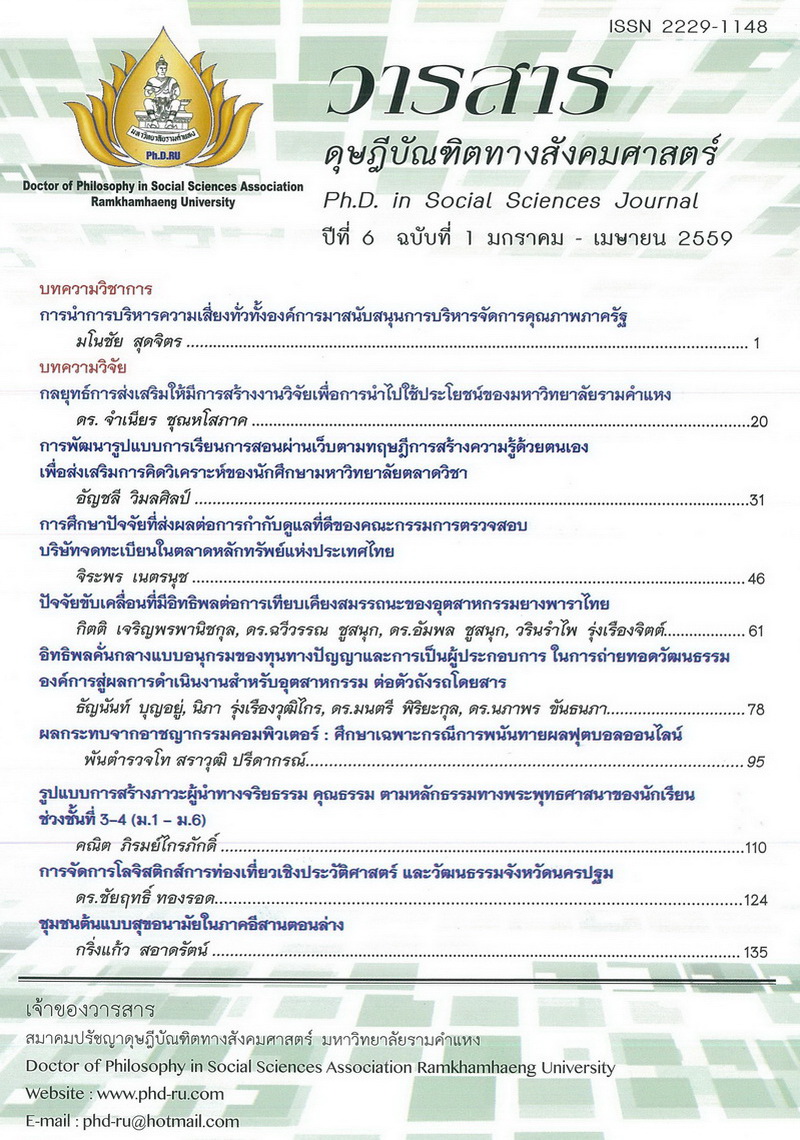ชุมชนต้นแบบสุขอนามัยในภาคอีสานตอนล่าง
Main Article Content
Abstract
ผลการวิจัยสรุปได้ดังนี้
1. โครงสร้างชุมชนในการจัดการสุขอนามัยของชุมชนที่เป็นแบบอย่าง ได้แก่ ผู้นำ และกลุ่มอาสา สมัครสาธารณสุข ใช้ภาวะผู้นำ วิถีชีวิตชุมชนในการรวมกลุ่ม และร่วมกันเลือกกิจกรรมสุขอนามัย ให้คุ้มบ้าน รับผิดชอบ ให้อาสาสมัครสาธารณสุขเป็นที่ปรึกษา และใช้เครือข่ายความสัมพันธ์ที่มีกับหน่วยงานให้การ สนับสนุนชุมชน
2. ความเป็นไปได้ในการนำแบบอย่างโครงสร้างชุมชนในการจัดการสุขอนามัยไปใช้ พบว่า ผู้มี ส่วนได้ส่วนเสียทุกกลุ่มสามารถนำโครงสร้างชุมชนในการจัดการสุขอนามัยของชุมชนบ้านคำกลางไปใช้ได้ กิจกรรมที่เห็นว่าจะนำไปใช้ไม่ได้ ได้แก่ การรวมกลุ่มออกกำลังกาย เนื่องจากยังไม่เคยเข้าร่วมกลุ่มมาก่อน
3. ต้นแบบ (model) ชุมชนสุขอนามัยที่เหมาะสมกับชุมชนในภาคอีสานตอนล่าง ได้แก่ (1) ชุมชน จัดการเรื่องสุขอนามัยไปพร้อมกับการจัดการด้านเศรษฐกิจ สังคมและวัฒนธรรม และสภาพแวดล้อม โดยใช้ความเชื่อ ค่านิยม และแบบแผนพฤติกรรมสร้างการรวมกลุ่ม และตัดสินใจเลือกกิจกรรม สุขอนามัย (2) กลุ่มคุ้มบ้านต้องรับผิดชอบ และตัดสินใจเลือกวิธีการจัดการสุขอนามัย โดยอาสาสมัคร สาธารณสุขเป็นที่ปรึกษา (3) ชุมชนจัดการสุขอนามัย ด้วยบุคคล ความรู้ ทรัพยากร เงินทุน และสถานที่ๆ ชุมชนมี โดยผู้นำชุมชนและกลุ่มอาสาสมัครสาธารณสุขสร้างเครือข่ายความร่วมมือ และการแบ่งปันให้เกิด ขึ้นในชุมชน รวมทั้งใช้เครือข่ายความร่วมมือที่มีอยู่กับหน่วยงานต่างๆ ในการสนับสนุนชุมชน
A HEALTH COMMUNITY MODEL FOR THE LOWER NORTHERN REGION
In this qualitative research investigation, the researcher studies (1) the components of community structure for the management of Ban Kham Klang community, Yasothon province. (2) the management methods of the community under study. Furthermore, the researcher investigates (3) Model of a health community for the lower northern region. by (1) Data collection of quality from a document dvd vision report to the interview to observe a group conversation at the community house at Yasothon province, Important Information 20 people and 1 Group , Content Analysis of data and apply the findings to create a simple model. (2) Collect the quantitative data from the 8 community in the lower northern region from group the leader , group people and groups health officials, including 404 people by using a query to the interview and meeting , the Analysis of (3) Create a Model of community health from research qualitative and quantitative result to compare and update the content for appropriate to the lower northern region
Findings are as follows:
1. The components of community structure constituting the social capital for the management of the Ban Kham Klang in Yasothon consisted of the following: Individuals who exercised leadership by deciding to lead their communities to participate in the project. They had good relationships with public health volunteers and others who were knowledgeable. They also had good relationships with subdistrict health promotion hospitals
2. In determining the feasibility of the implementation of community structure management methods for the Ban Kham Klang health community model in Yasothon, the researcher found the following. All stakeholder can be available to the community . The exercise aggregation can not available because never aggregation.
3. A health community model appropriate for communities in the lower northeastern region are as follows: (1) Holistic health management , Groups consisted of public health volunteers who had relationships as relatives with leaders and local residents by beliefs, values and behavioral patterns to participation in community.(2) Groups homes are responsible, determine about health management by leadership, responsibility and have consultant from public health volunteers (3) Health management from community resources, cooperation and sharing and use network management cooperation holistic health.
Article Details
Academic articles, research articles, and book reviews in the Ph.D. in Social Sciences Journal are author’s opinions, and not the publisher’s, and is not the responsibility of the Ph.D. in Social Sciences Journal Philosophy Association, Ramkhamhaeng University. (In the case that research is done on human, the researcher has to be trained in Ethics for Doing Research on Human Training and has to produce the evidence of the training).


